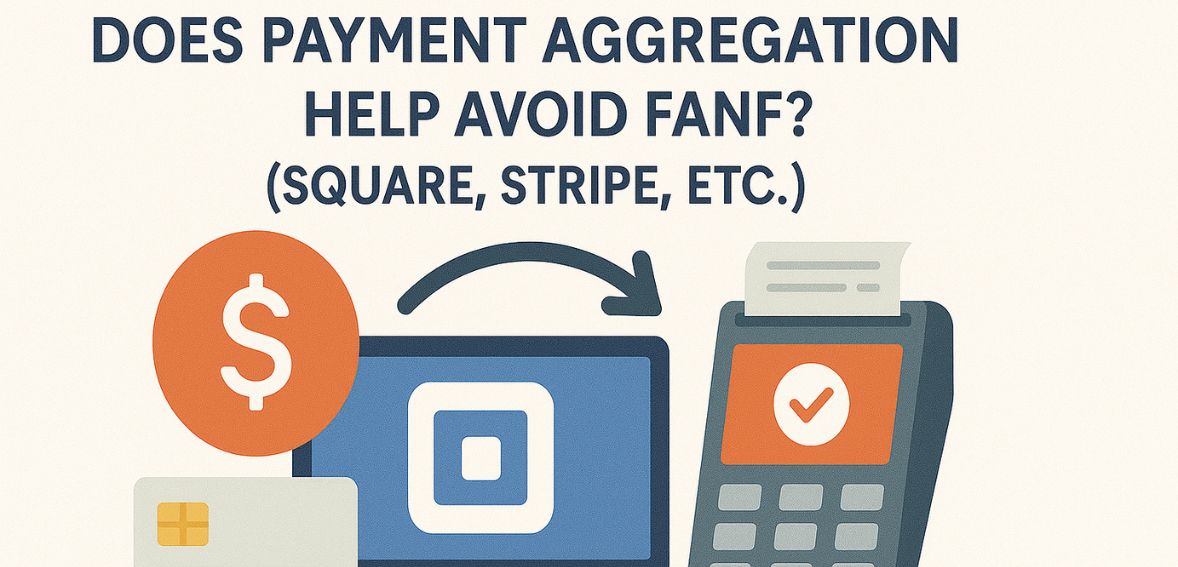
By Karen June 26, 2025
If you’ve ever run a small business—even just a weekend pop-up—you know those credit card processing fees can be downright confusing. It’s one of those hidden costs that quietly eat into your profits. Most business owners don’t even know it exists, but if you accept credit cards, chances are you’re already paying something called the Fixed Acquirer Network Fee—FANF for short. This raises a key question: Can payment aggregation actually help merchants avoid FANF altogether?
Since everything is going digital by 2025, small business owners are searching for more convenient and cost-effective ways to accept payments without incurring additional costs. This article explores whether merchants can avoid this frequently misinterpreted fee by using well-known payment aggregators like Square, Stripe, or PayPal, as well as the associated trade-offs.
Understanding What FANF Really Is

Visa won’t send you a bill in the mail, but don’t think you’re off the hook. They charge your payment processor, who quietly passes that cost on to you—usually buried somewhere in the fine print. That depends on a few things—like how you take Visa payments and how much volume you’re pushing each month. FANF is Visa’s way of covering the costs of running its massive card network. It doesn’t depend on how many sales you make, but on how you accept payments—whether it’s through a swipe machine, a mobile app, or online checkout.
For card-present merchants—those who use traditional terminals in physical stores—the fee is based on the quantity of physical merchant locations. The monthly volume of Visa transactions for merchants without physical cards—typically eCommerce sites or businesses that take payments over the phone—determines the fee.
A merchant’s fee tier increases with the volume of transactions they process. The structure is more complex than it first appears, though. The final amount is variable due to a tiered system and the exclusion or adjustment of specific merchant categories.
One of the more frustrating aspects of FANF is that it rarely appears clearly on monthly statements, making it difficult for merchants to identify or even realize they’re paying it. How FANF appears on statements often varies by provider and is usually embedded under vague line items or blended into broader fee structures. Merchants often become aware of it only after closely analyzing their effective rate or by reviewing their ISO/MSP agreement. And because it’s so buried, many business owners start looking for simpler, more transparent ways to take payments.
What Are Payment Aggregators

If you’ve used Square or Stripe to get paid, you’ve already worked with a payment aggregator. These companies bundle lots of small businesses into one big account. Think of it like carpooling your transactions—everyone shares the ride, and the aggregator handles the logistics.
The aggregator and the card networks technically have an acquiring relationship because merchants that use these platforms lack their own unique merchant IDs (MIDs). Consequently, Visa charges fees, such as FANF, at the aggregator level rather than at the merchant level. Whether or not the merchant is ultimately responsible for paying FANF directly depends on this structural difference.
Merchants who use payment aggregators are frequently protected from FANF in its conventional form. They are not included in the standard FANF assessment tiers because they do not possess an independent merchant account. But don’t be fooled—it doesn’t mean you’re not footing the bill in other ways.
Are Aggregators Really Helping You Avoid FANF?
Sure, Square and Stripe help you dodge a FANF fee showing up on your bill. But that doesn’t mean you’re not paying for it. They just roll it into their flat-rate pricing. It might seem easier with no surprise charges, but that simplicity often comes at a higher cost.
On paper, it’s a nice perk—FANF isn’t listed as a separate charge, which helps keep monthly statements cleaner and makes budgeting easier for merchants. Additionally, the flat-rate pricing model adopted by most aggregators absorbs all interchange and network fees into a single percentage-based charge—often something like 2.9% + $0.30 per transaction.
However, the trade-off lies in the overall cost structure. While merchants may avoid FANF, they often pay a higher effective rate overall when compared to traditional merchant accounts, especially as monthly volumes increase.
In other words, you might save $15–$45 a month on FANF, but end up paying several hundred more in transaction fees because you’re stuck with flat pricing that doesn’t adjust with volume. In short? You dodge one fee, but you might be stepping into a more expensive system overall.
Operational Benefits of Aggregators Beyond FANF

Avoiding FANF is just one reason small merchants choose aggregators. Another strong motivator is speed and simplicity. Setting up a traditional merchant account can take days, sometimes weeks, and may involve credit checks, bank verification, and compliance documentation. Aggregators, on the other hand, allow businesses to start accepting payments almost instantly.
These platforms throw in all the bells and whistles—user-friendly dashboards, simple integrations, and even mobile tools that let you take payments on the fly. For businesses focused on agility and ease of use, these features are just as important—if not more—than minor differences in monthly fees like FANF.
Moreover, aggregators handle PCI compliance responsibilities. That’s a huge plus for solopreneurs or small teams who might not have the time—or technical know-how—to tackle compliance on their own.
Since the payment data flows through their infrastructure, they often certify and maintain compliance for the broader ecosystem, removing much of the regulatory burden from individual merchants. In contrast, traditional merchant accounts require that the merchant independently complete SAQs, maintain tokenization practices, and comply with security audits.
Long-Term Cost Implications and Business Growth
The more your business grows, the more you start noticing that those flat-rate fees aren’t doing you any favors. Merchants processing $20,000 or more per month typically find that the convenience of an aggregator becomes cost-prohibitive. If your margins are tight, even a few extra cents per swipe can start to hurt more than that $20 fee you thought you were avoiding. These benefits become crucial as monthly volumes increase and margins tighten.
More importantly, FANF is only one of many fees, even though it is not insignificant. Changing to a full-service payment processor could help expanding businesses with reporting, funding schedules, and fraud protection. Actually, some more recent processors are combining the best features of aggregators and aggregators without the rigidity.
Additionally, switching allows companies to manage their own merchant ID, which can improve their interactions with card networks and banks. When disagreements emerge or when aggregators are unable or unwilling to offer customized solutions, this control frequently becomes important.
Contract transparency and dispute resolution

A lot of businesses hit a wall and say they need more control over how their money is handled, especially during disputes or chargebacks. While aggregators offer streamlined support, their platform-centric approach can delay resolution and limit merchant influence in the outcome.
With a traditional merchant account, the business has direct access to their acquirer, dispute portals, and sometimes even dedicated relationship managers—many of whom work closely with the role of ISOs and MSPs to support merchants more directly. This extra layer of transparency becomes increasingly valuable in industries with higher chargeback ratios or complex billing cycles.
Additionally, contract structures under traditional merchant accounts can be negotiated for lower rates, value-added services, and tailored pricing models—features that aggregators typically do not offer. Therefore, while aggregators may help businesses sidestep FANF and some early headaches, they may become less suited for businesses seeking greater autonomy over time.
FANF and the Future of Aggregated Processing in 2025

Fast forward to 2025, and the aggregator game is still going strong—but it’s also changing. With increased competition in the FinTech sector and regulatory changes on the horizon, aggregators are finding new ways to retain merchants, including offering advanced analytics, loyalty programs, and AI-driven fraud mitigation.
Visa and other card networks are currently reviewing the way fees such as FANF are implemented. The line between card-present and card-not-present transactions is becoming becoming increasingly unclear as more companies switch to eCommerce and mobile-first payment methods.
Future modifications to FANF’s structure may result from this. The card networks might start evaluating fees differently depending on user behavior, transaction velocity, or risk factors rather than just location or volume.
As compliance frameworks evolve, aggregators may eventually be obliged to pass along a portion of these fees to sub-merchants. However, as part of their platform pricing strategy, they are still bearing these costs for the time being. It should come as no surprise that smaller or newer companies frequently choose aggregators, particularly when attempting to avoid perplexing fees like FANF.
Conclusion: Weighing the Trade-Offs in a Complex Ecosystem
There’s no denying that Square and Stripe make life easier when you’re just getting started. The model simplifies operations, speeds up onboarding, and reduces visible cost complexity. But these advantages come with trade-offs, particularly for businesses that scale.
Flat fees sound simple—until they start eating into your profits. And when something goes wrong, you may find yourself stuck waiting in a support queue instead of talking to someone who can actually fix it. At the end of the day, you have to ask—Is FANF the big problem, or just one piece of a bigger puzzle? Knowing how this fee works lets you choose smarter processing options and avoid losing money to hidden costs.
As we move deeper into 2025, choosing between an aggregator and a traditional processor will require businesses to evaluate more than just fees—they’ll need to consider support, customization, growth trajectory, and operational resilience.
For some, avoiding FANF will remain a driving factor. For others, long-term savings and control will outweigh the short-term simplicity aggregators offer.